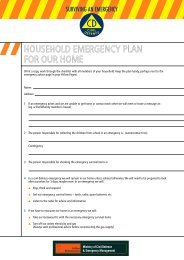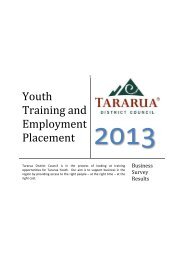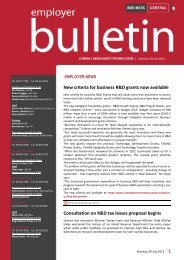Food Control Plan Checklist - Tararua District Council
Food Control Plan Checklist - Tararua District Council
Food Control Plan Checklist - Tararua District Council
- No tags were found...
Create successful ePaper yourself
Turn your PDF publications into a flip-book with our unique Google optimized e-Paper software.
Serve SafeReheating prepared food1 Goal 2 Why?To reheat food quickly and thoroughly.To reduce the amount of time readily perishable food is held inthe temperature danger zone (4ºC to 60ºC).• Microbes can survive in food that is not thoroughly reheatedto the centre.• <strong>Food</strong> in the temperature danger zone (4ºC to 60ºC) willencourage harmful microbes to grow rapidly.3 How this is doneReheat food well• Use equipment that reheats food effectively.Bains-marie and warming cabinets must not beused to reheat food because they can’t reheat foodquickly enough.• The following methods are used to reheat food:[tick as appropriate]microwave (note: observe standing times)ovenpot/pan/wok etc.• Where possible, stir or mix food to make sure there are nocold spots and the food is evenly reheated.• When reheating poultry a probe thermometer is used tocheck that it reaches an internal temperature of 75ºC(see Checking temperatures).• Check that food has been reheated properly using the samechecks used when cooking (see Cooking).• Serve reheated food quickly or maintain it at 60ºC or hotter.4 What if there is a problem?If food does not reheat sufficiently increase temperature and/or reheating time.Retrain staff as necessary.5Write it downOnce a week write down in the Diary thetemperature of one poultry item that hasbeen reheatedWrite down any problems that you have hadin reheating food and what action you took.Use of plastics in microwave ovens• Avoid direct contact of plastic film with foodwhen using it to reheat food. Clean whiteabsorbent kitchen paper may be a preferablealternative to prevent splatter.• Only use plastic containers designed for use inthe microwave. Other containers may seem okay,but may not have been tested for use at hightemperatures (eg, ice cream containers, whichmay not be designed to be exposed to hightemperatures).• As chemical migration is more likely to occur intohot fatty foods, glass containers are a suitablechoice for heating these products.<strong>Food</strong> <strong>Control</strong> <strong>Plan</strong> Version 3.0 2011S13







